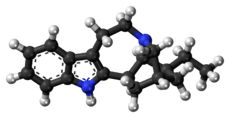Ibogamine
Ibogamine|
|
 |
| Clinical data |
|---|
| ATC code |
none |
|---|
| Identifiers |
|---|
- [6R-(6α,6aβ,7β,9α)]-7-ethyl-6,6a,7,8,9,10,12,13-octahydro-6,9-methano-5H-pyrido[1',2':1,2]azepino[4,5-b]indole
|
| CAS Number |
481-87-8  N N |
|---|
| PubChem (CID) |
100217 |
|---|
| ChemSpider |
90568  Y Y |
|---|
| ChEBI |
CHEBI:5853  Y Y |
|---|
| Chemical and physical data |
|---|
| Formula |
C19H24N2 |
|---|
| Molar mass |
280.41 g/mol |
|---|
InChI=1S/C19H24N2/c1-2-13-9-12-10-16-18-15(7-8-21(11-12)19(13)16)14-5-3-4-6-17(14)20-18/h3-6,12-13,16,19-20H,2,7-11H2,1H3/t12-,13+,16+,19+/m1/s1  Y YKey:LRLCVRYKAFDXKU-YGOSVGOTSA-N  Y Y
|
 N N Y (what is this?) (verify) Y (what is this?) (verify) |
|---|
Ibogamine is an alkaloid found in Tabernanthe iboga.[1][2]
Basic research related to how addiction affects the brain has used this chemical.[3]
Ibogamine persistently reduced the self-administration of cocaine and morphine in rats.[4]
See also
References
- ↑ Bartlett, M. F.; Dickel, D. F.; Taylor, W. I. (1958). "The Alkaloids of Tabernanthe iboga. Part IV.1 The Structures of Ibogamine, Ibogaine, Tabernanthine and Voacangine - Journal of the American Chemical Society (ACS Publications)". Journal of the American Chemical Society. 80 (1): 126–136. doi:10.1021/ja01534a036.
- ↑ Kuehne, Martin E.; Reider, Paul J. (1985). "A synthesis of ibogamine - The Journal of Organic Chemistry (ACS Publications)". The Journal of Organic Chemistry. 50 (9): 1464–1467. doi:10.1021/jo00209a020.
- ↑ Levi MS, Borne RF (October 2002). "A review of chemical agents in the pharmacotherapy of addiction". Curr. Med. Chem. 9 (20): 1807–18. doi:10.2174/0929867023368980. PMID 12369879.
- ↑ Glick SD, Kuehne ME, Raucci J, Wilson TE, Larson D, Keller RW Jr, Carlson JN (September 1994). "Effects of iboga alkaloids on morphine and cocaine self-administration in rats: relationship to tremorigenic effects and to effects on dopamine release in nucleus accumbens and striatum.". Brain Res. 657 (1-2): 14–22. doi:10.1016/0006-8993(94)90948-2. PMID 7820611.
|
|---|
|
| MOR |
- PAMs: BMS-986121
- BMS-986122
|
|---|
|
| DOR | |
|---|
|
| KOR |
- Agonists: 6'-GNTI
- 8-CAC
- 18-MC
- 14-Methoxymetopon
- β-Chlornaltrexamine
- β-Funaltrexamine
- Adrenorphin (metorphamide)
- Akuuamicine
- Alazocine
- Allomatrine
- Asimadoline
- BAM-12P
- BAM-18P
- BAM-22P
- Big dynorphin
- Bremazocine
- BRL-52537
- Butorphan
- Butorphanol
- BW-373U86
- Cebranopadol
- Ciprefadol
- CR665
- Cyclazocine
- Cyclorphan
- Cyprenorphine
- Diamorphine (heroin)
- Diacetylnalorphine
- Difelikefalin
- Dihydroetorphine
- Dihydromorphine
- Diprenorphine
- Dynorphin A
- Dynorphin B (rimorphin)
- Eluxadoline
- Enadoline
- Eptazocine
- Erinacine E
- Ethylketazocine
- Etorphine
- Fedotozine
- Fentanyl
- Gemazocine
- GR-89696
- GR-103545
- Hemorphin-4
- Herkinorin
- HS665
- Hydromorphone
- HZ-2
- Ibogaine
- ICI-199,441
- ICI-204,448
- Ketamine
- Ketazocine
- Laudanosine
- Leumorphin (dynorphin B-29)
- Levallorphan
- Levomethorphan
- Levorphanol
- Lexanopadol
- Lofentanil
- LPK-26
- Lufuradom
- Matrine
- MB-1C-OH
- Menthol
- Metazocine
- Metkefamide
- Mianserin
- Mirtazapine
- Morphine
- Moxazocine
- MR-2034
- N-MPPP
- Nalbuphine
- Nalbuphine sebacate
- NalBzOH
- Nalfurafine
- Nalmefene
- Nalodeine (N-allylnorcodeine)
- Nalorphine
- Naltriben
- Niravoline
- Norbuprenorphine
- Norbuprenorphine-3-glucuronide
- Noribogaine
- Norketamine
- O-Desmethyltramadol
- Oripavine
- Oxilorphan
- Oxycodone
- Pentazocine
- Pethidine (meperidine)
- Phenazocine
- Proxorphan
- Racemethorphan
- Racemorphan
- RB-64
- Salvinorin A (salvia)
- Salvinorin B ethoxymethyl ether
- Salvinorin B methoxymethyl ether
- Samidorphan
- SKF-10047
- Spiradoline (U-62,066)
- TH-030418
- Thienorphine
- Tifluadom
- Tricyclic antidepressants (e.g., amitriptyline, desipramine, imipramine, nortriptyline)
- U-50,488
- U-54,494A
- U-69,593
- Xorphanol
|
|---|
|
| NOP | |
|---|
|
| Unsorted | |
|---|
|
| Others |
- Others: Kyotorphin (met-enkephalin releaser/degradation stabilizer)
|
|---|
|
See also: Peptide receptor modulators |

